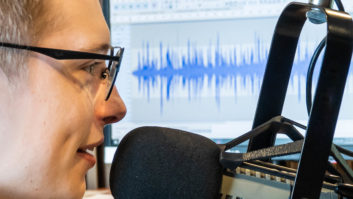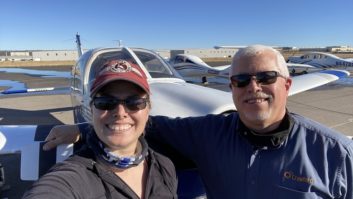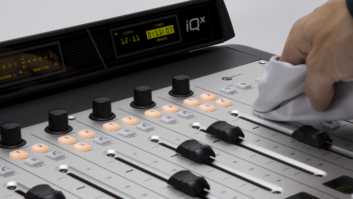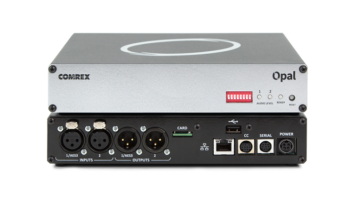Making the Final Cut
Sep 1, 2005 12:00 PM, By Gary Eskow
Although many digital audio workstation manufacturers initially geared their product lines towards the music and audio for video markets, the relevance of this technology to radio production has become apparent. Many of the features that full-blown DAWs offer–midi implementation and the ability to import video files, for example–may not reference the needs of the radio marketplace. Other features, however, have become essential. In the fast-paced world of radio production, what do you need to know about DAWs, and how do you squeeze the most out of their assets?
At the typical radio station, people holding a variety of job titles will have input when it comes to creating a station’s image spots and promos. Larger stations may have an imaging director (or several), whose full-time job is to direct and advance the identity of the station. Copywriters, producers and even the jocks themselves may be involved in the creation of a spot. How important is it that they become knowledgeable about how digital audio is recorded, manipulated and delivered?
Very important, according to Rob Chickering, engineering manager for Susquehanna Radio’s Dallas stations. “Our production process takes place on multiple levels,” said Chickering. “We need a DAW that can be tailored to the technical capabilities of different users.”
After considering a variety of platforms, Chickering outfitted Susquehanna’s Dallas stations with Nuendo workstations, which run on off-the-shelf Dell Precision computers. Also in line are RME Hammerfall 9652 I/O cards and Yamaha 01V96 consoles.

A dedicated controller is an available option for many systems.
Like most radio production users, Chickering’s staff typically produces spots with 30 or more tracks. Keeping track of multiple clips, and being able to label the routing structure within a DAW is critically important.
“I like the clarity of Nuendo’s Audio Pool,” said Chickering. The Nuendo also lets the user label routing assignments. Is this feature important to you? If so, make sure the DAW you’re considering buying includes it.
Experience counts
If users with differing levels of experience with audio technology will be using your platform, purchase a DAW that can be understood by everyone, or tailored to suit the needs of a variety of operators. Using several of Nuendo’s templates as starting points, Chickering created skins designed to accommodate the skills of individual staff members, including several imaging directors who are more knowledgeable about audio technology than many others, and producers who can do more, including apply effects, tweak the equalization of individual tracks and normalize (adjust the output level for maximum impact) the final mix. Do you routinely incorporate audio material collected from outside sources? If so, working on a DAW that can import a variety of file formats, including AIFF, Broadcast WAV (BWF) and MP3, is vital.
All of the DAWs on the market can load a clip, scrub through it and non-destructively choose the bits wanted in the assembly of the final spot. Typically, the front end of all these software applications includes a transport section modeled on the controls of a tape recorder. Each one, however, has a different feel. Adobe’s Audition, one of the most popular digital audio workstations among radio users, allows the user to load multiple tracks of audio, scrub and create clips from longer audio elements. The newest version of this application (1.5) includes a timeline that can stretch a clip to fit the exact requirement of a spot. Other applications include this feature as well. How do they handle this function–specifically, which alters the quality of a clip the least–and can you make a price and performance determination between them?
Adobe Audition 1.5 ships with more than 5,000 royalty-free loops, and this library could be a deal maker for the user who builds music beds. In addition to the full audio tracks, all of the loops come as elements as well. Start out with a bass line, add drums at the mid-point, save the screaming guitar for the outro, and you may be golden.
When DAWs (with Pro Tools at the forefront) began to eclipse traditional multi-track tape recorders and hardware consoles in recording studios, the generally accepted thought was that physical faders would never disappear. Producers were simply too much in love with the tactile pleasure of turning knobs and sliding faders up and down. As it turns out, however, many producers have adapted to the mouse. Although hardware controllers are popular with many users, they are not ubiquitous in recording studios and audio post suites.
Do you need a controller? Charlie Brown of Audion Labs says that almost all users who purchase Audion Labs’ Voxpro DAW also buy the company’s control panel.
“Is it necessary?” asks Brown. “No. As a matter of fact, the help menu has a resizable, graphic of a computer keyboard with all the editing commands labeled, and rollovers describing the function the various icons represent. In some cases folks input commands only via the keyboard.”
The 360 Systems Short Cut is a hardware-based, two-track system in a desktop package. The controller surface is the user interface. While there is a microprocessor and hard drive inside, it does not feel like a computer, which some users may like. Other manufacturers, such as Tascam, Roland and Korg produce hardware-based systems that include a mixer, recorder and some effects in one package.
Being connected
Does your station need to gang multiple DAWs into a network? If so, studying how different applications handle networking–or if they have this capability at all–is vital. Voxpro, for example, can export multiple files at one time to any DAW that sits on a LAN. Voxpro 4.0 also has an auto-import feature that scans a designated directory every 30 seconds. Any data that has been dropped into this directory � traffic and weather reports, for example � is automatically made available.
Do you need a DAW that supports Cart Chunk? Some systems don’t support Cart Chunk, but instead rely on their own proprietary chunk. By default, this application converts all incoming data to its own internal format (44.1kHz, 16-bit), but this setting can be disabled. Once again, how you handle multiple formats, on both the import and export side is critically important. More and more common, for example, is the delivery of voice over tracks as MP3 files directly from the talent’s home studio. Only several years ago, the use of ISDN lines was considered the ultimate in futuristic transmission of this type of audio data. We’ll leave the discussion of the degradation of the public’s appreciation of audio quality caused by the introduction of the MP3 for another day, and focus on the practical reality: no local radio station wants to foot the bills associated with ISDN when MP3s can be recorded and delivered for almost no cost. Make sure your DAW can convert these files, or handle multiple file formats at one time, if you’re working with MP3s.
Mirroring the production values that can be found on CDs and in videos, radio spots are becoming increasingly sophisticated. How much effort do you want to put into applying effects to your audio tracks? Faster computers and remarkably affordable software effects have made it possible for almost any user to assemble the tools that can polish (or pound) your clips. Many software processors come in Direct X and VST formats–but not all. This last statement presupposes, of course, that you’re working on a PC and not a Mac. If you’re in love with a particular effect, but it only ships as a VST plug-in, don’t assume that your DAW can use it.
Although hardware work stations still have their champions, among them those who feel that they are more crash resistant than software DAWs running on standard computers, the trend clearly favors the technology profiled in this piece. Simply purchasing a set of disks and installing them on your computer is not enough, however. If you’re considering bringing audio production in house, you’ll need to ask the kinds of questions we’ve covered in this article, and make an educated decision when it’s time to plunk down your boss’s hard-earned bucks.
Eskow is a freelance technology writer in New Jersey, and contributing editor to Radio magazine’s sister publication Mix magazine.
Resource Guide
A sample of manufacturers of DAWs and accessories.
360 Systems
818-991-0360
www.360systems.com
Acoustica
559-692-2224
www.acoustica.com
Adobe Systems
800-833-6687
www.adobe.com
Audion Laboratories
206-842-5202
www.audionlabs.com
Bias
800-775-2427
www.bias-inc.com
Digidesign
800-333-2137
www.digidesign.com
Digigram
703-875-9100
www.digigram.com
Digital Audio Research
+44 1707 665000
www.dar.uk.com
Digital Juke Box
740-282-SOFT
www.digitaljukebox.com
Korg
631-390-6500
www.korg.com
Mackie
800-898-3211
www.mackie.com
Merging Technologies
858-675-9703
www.merging.com
Netia Digital Audio
866-638-4222
www.netia.net
Otari
800-877-0577
www.otari.com
Roland
800-542-2307
www.rolandus.com
Sadie
615-327-1140
www.sadie.com
SAW Studio
�
www.sawstudio.com
Sonic Desktop Software
800-454-1900
www.smartsound.com
Sonic Solutions
800-225-1656
www.sonic.com
Sony Electronics
800-686-SONY
www.sony.com/proaudio
Steinberg
818-993-4161
www.us.steinberg.net
Studer
818-920-3212
www.studer.ch
Tascam/Teac Professional
323-726-0303
www.tascam.com
TC Electronic
818-665-4900
www.tcelectronic.com
Waves
865-546-6115
www.waves.com
Yamaha
714-522-9000
www.yamaha.com/proaudio
Resource Guide Special
Manufacturers of sound cards and computer audio interfaces.
Antex Electronics
800-338-4231
www.antex.com
Audio Science
302-324-5333
www.audioscience.com
Axia Audio
216-241-7225
www.axiaaudio.com
Creative Labs
800-998-1000
www.americas.creative.com
Digigram
703-875-9100
www.digigram.com
Digital Audio Labs
612-559-9098
www.digitalaudio.com
Edirol
360-594-4273
www.edirol.com
Lynx Studio Technology
949-515-8265 � 205
www.lynxstudio.com
Sydec Audio Engineering
+32-3-7650098
www.sydec.be












